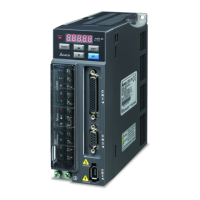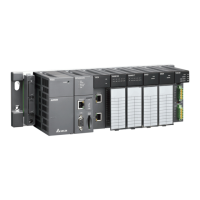ASDA-B2 Chapter 2 Installation
Revision May, 2018 2-15
resistor will do. Generally speaking, when the need of the external load inertia is not
much, the built-in regenerative is enough. The diagram below describes the actual
operation. The smaller power of the regenerative resistor it is, the more energy it
accumulates and the higher temperature it will be. When the temperature is higher than
a specific value, ALE05 occurs.
(b) If the external load torque exists, the motor is in reverse rotation.
Usually, the motor is in forward rotation, which means the torque output direction
of the motor is the same as the rotation direction. However, in some applications,
the direction of torque output is different from the rotation. In this situation, the
motor is in reverse rotation. The external energy goes into the servo drive
through the motor. The diagram below is one example. When the external force
direction is the same as the moving direction, the servo system has to use the
force of the opposite direction to keep the speed and stability. Huge amount of
energy will return to the servo drive at the moment. When DC-BUS is full and
unable to store the regenerative energy, the energy will be leaded to regenerative
resistor and consumed.
Motor Rotation Speed
External Load Torque
Motor Output Torque
Reverse
Rotation
Reverse
Rotation
Forward
Rotation
Forward
Rotation
Negative torque: TL × Wr TL: external load torque
For safety reasons, please calculate it by considering the safest situation.
For example, when the external load torque is the +70% rated torque and the rotation
reaches 3000 r/min, then take 400 W (the rated torque is 1.27 Nt-m) as the example,
the user has to connect the regenerative resistor of 40, which is 2 × (0.7× 1.27) × (3000
× 2 × π/60) = 560W.

